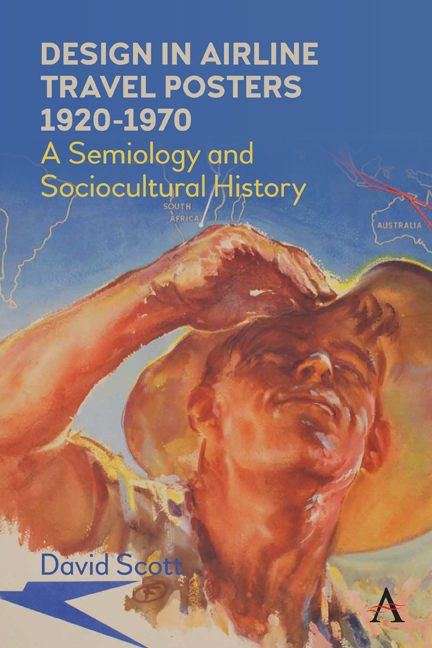Book contents
- Frontmatter
- Dedication
- Contents
- List of Figures
- Introduction
- 1 Fact and Fantasy: Reading and Misreading the Poster Image
- 2 People, Places and Planes: Destinations and Itineraries
- 3 Looking Out and Looking Up: Framing Devices and Indexical Signs
- 4 Indigenous Peoples
- 5 Glamour and Sex Appeal: Designing Desire
- Conclusion: The Decline of the Airline Travel Poster
- References
- Index
Conclusion: The Decline of the Airline Travel Poster
Published online by Cambridge University Press: 09 February 2021
- Frontmatter
- Dedication
- Contents
- List of Figures
- Introduction
- 1 Fact and Fantasy: Reading and Misreading the Poster Image
- 2 People, Places and Planes: Destinations and Itineraries
- 3 Looking Out and Looking Up: Framing Devices and Indexical Signs
- 4 Indigenous Peoples
- 5 Glamour and Sex Appeal: Designing Desire
- Conclusion: The Decline of the Airline Travel Poster
- References
- Index
Summary
As was noted in the introduction, the advent of modern colour photography and mass televisual information coincided with both the decline of the airline poster and the increased democratization of airline travel: the jet age and intense commercial competition have ushered in a very different approach to airline promotion from that of the pre-1960s. In the modern period air travel has become banal, a mass phenomenon, intrinsic to the global expansion of tourism as well as business; as Hudson and Pettifer confirm, for every one passenger in 1939, there were 1000 in 1979 (1979: 90). As a result, the images used to promote it draw increasingly on a standardized, internationalist repertory that one might find in any glossy magazine or journal and so lose much of the specific flavour and charm evident in posters produced for public display in a less democratic and homogeneous era. In an age when the concept of exoticism has become problematic – the modern air traveller being as likely as not to be him-or herself previously categorized as ‘exotic’ (i.e. non-Western) – it becomes increasingly difficult to romanticize travel destinations. The skyline and airport at the many scheduled points of arrival or departure are furthermore becoming more difficult to distinguish from each other. This is in particular true of the airport itself which is now generally recognized as being a non-lieu or non-place, that is, a site lacking in historical, cultural or individual significance: it is a place of banality, boredom and delay. The aircraft has in a similar way become emptied of individual character: all models, whether manufactured by Airbus or by Boeing, are virtually identical in appearance and are indeed very often not seen from the outside at all by their passengers who board them along a covered gangway. Plane-spotting, like trainspotting, has become a thing of the past. The focus on destination in its larger sense rather than itinerary has further reduced the imaginative appeal of travel and its scope for representation.
The text of Design in Airline Travel Posters opened with a comparison of two posters from two very different ages of airline travel, one from 1959 (a moment close to the chronological limit of this study) and one of 1990.
- Type
- Chapter
- Information
- Design in Airline Travel Posters 1920–1970A Semiology and Sociocultural History, pp. 113 - 116Publisher: Anthem PressPrint publication year: 2021

